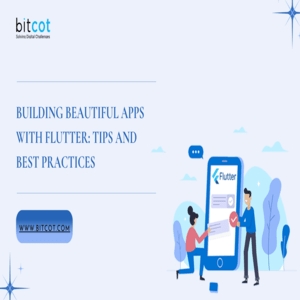Building Beautiful Apps with Flutter: Tips and Best Practices
Posted by Raj Sanghvi on April 30th, 2024
Introduction:
Flutter has emerged as a powerful framework for building beautiful and performant cross-platform mobile applications. With its rich set of widgets, expressive UI designs, and fast development cycle, Flutter offers developers the tools they need to create stunning user experiences. In this blog post, we'll explore some tips and best practices for building beautiful apps with Flutter.
1. Follow Material Design Guidelines:
Google's Material Design guidelines provide a comprehensive set of principles and best practices for designing intuitive and visually appealing user interfaces. By following Material Design guidelines, you can ensure consistency across your app's UI elements, typography, colors, and layout. Flutter comes with built-in support for Material Design, making it easy to implement Material Design components and patterns in your app.
2. Use Flutter Widgets Effectively:
Flutter offers a wide range of customizable widgets that can be used to build complex UI layouts and interactions. Familiarize yourself with Flutter's widget catalog and use widgets effectively to achieve the desired UI design. Whether it's buttons, text fields, lists, or animations, Flutter provides widgets for almost every UI element you need. Use Flutter's layout widgets like Row, Column, Stack, and Expanded to create flexible and responsive layouts.
3. Optimize Performance:
Performance is crucial for delivering a smooth and responsive user experience. Optimize your Flutter app's performance by minimizing unnecessary renders, reducing widget rebuilds, and optimizing layout constraints. Use tools like the Flutter Performance Profiler to identify performance bottlenecks and optimize your app's rendering performance. Consider lazy loading content, caching assets, and using the Flutter SDK's performance optimization features to improve your app's overall performance.
4. Customize UI with Themes:
Flutter's ThemeData class allows you to define custom themes for your app, including colors, typography, and shapes. Use themes to define a consistent visual style for your app and easily apply custom styles across different UI components. By defining a theme for your app, you can ensure visual consistency and make it easier to maintain and update your app's design.
5. Implement Responsive Design:
With Flutter, you can build responsive UI layouts that adapt to different screen sizes and orientations. Use Flutter's MediaQuery class to retrieve information about the device's screen size and orientation and adjust your UI layout accordingly. Consider using Flutter's layout widgets like Flexible and Expanded to create responsive UI layouts that scale gracefully on different devices.
6. Test Across Devices and Platforms:
Testing is essential to ensure that your Flutter app looks and behaves as expected across different devices and platforms. Use Flutter's built-in testing framework to write unit tests, widget tests, and integration tests for your app. Test your app on a variety of devices with different screen sizes, resolutions, and operating systems to identify and fix any compatibility issues.
7. Iterate and Gather Feedback:
Building a beautiful app is an iterative process that requires continuous refinement and improvement. Gather feedback from users, stakeholders, and other developers to identify areas for improvement and iterate on your app's design. Use tools like Firebase Analytics or user feedback forms to collect feedback from users and prioritize enhancements based on user needs and preferences.
Conclusion:
Building beautiful apps with Flutter requires attention to detail, creativity, and a solid understanding of Flutter's capabilities. By following these tips and best practices, you can create visually stunning and performant Flutter apps that delight users and stand out in the crowded app marketplace. Embrace Flutter's flexibility and expressiveness to unleash your creativity and build the next generation of mobile experiences.
Also Read: What is Flutter App Development? [Step by Step Guide 2023]



